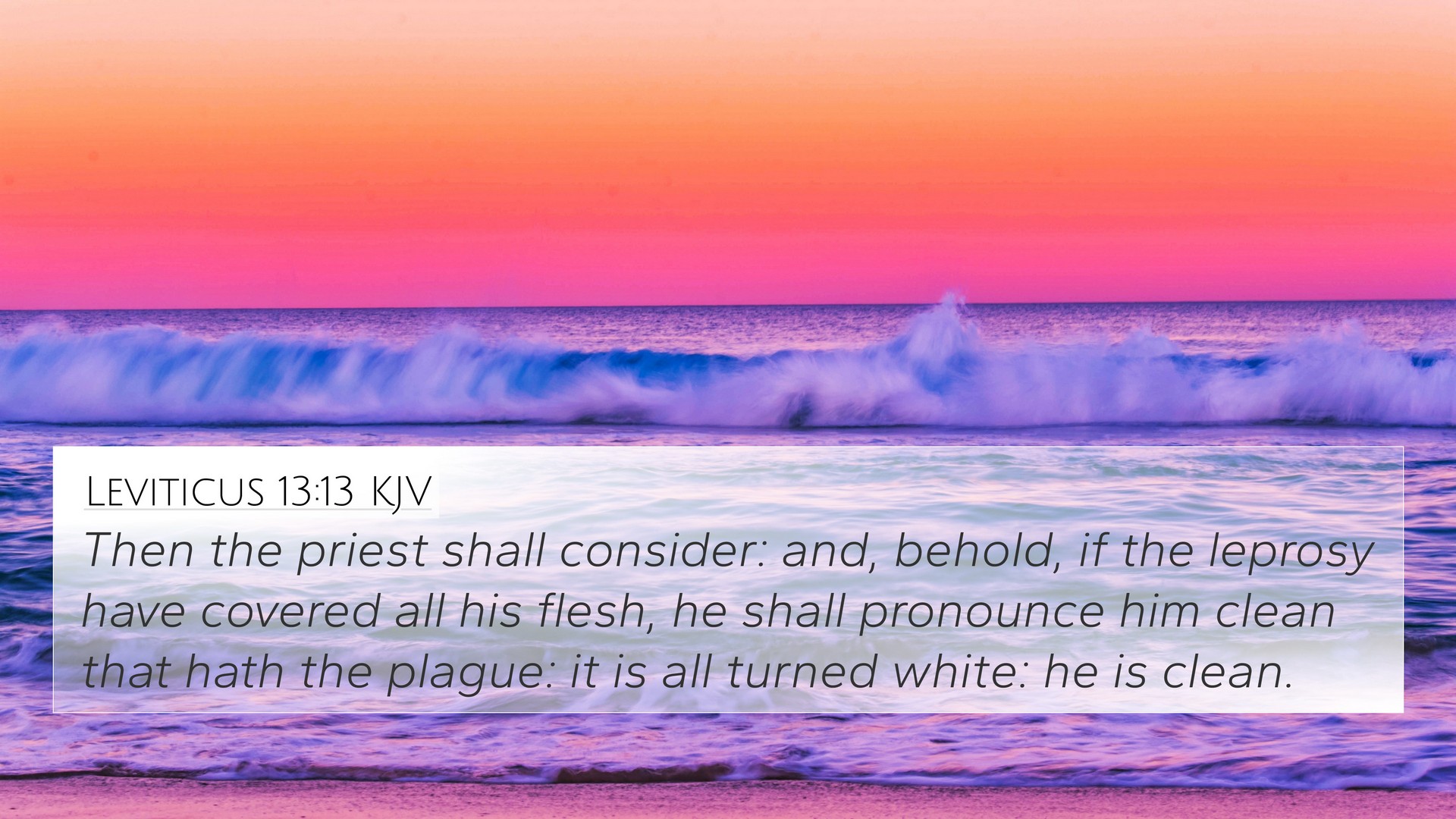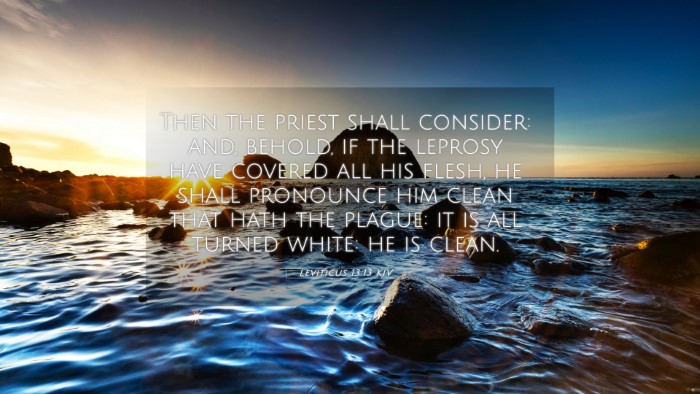Understanding Leviticus 13:13
Leviticus 13:13 reads, "Then the priest shall consider; and, behold, if the leprosy have covered all his flesh, he shall pronounce him clean that hath the plague: it is all turned white: he is clean." This verse is situated within the broader context of laws regarding skin diseases, particularly leprosy, and underscores the role of the priest as a mediator in determining the state of purity or defilement.
Summary of Insights from Commentaries
This passage has received various interpretations, focusing primarily on the themes of purity, judgment, and the grace of God. Below, insights are drawn from the public domain commentaries such as those by Matthew Henry, Albert Barnes, and Adam Clarke.
Matthew Henry's Commentary
Matthew Henry emphasizes the importance of external signs of inward grace. He notes that the leprosy symbolizes sin, and the priest's role is crucial in acknowledging the state of a person's spiritual condition. The command reflects that a total manifestation of leprosy—as noted by the skin turning entirely white—leads to a declaration of cleanliness, symbolizing God’s complete forgiveness and acceptance when a person is wholly surrendered to Him.
Albert Barnes' Commentary
Albert Barnes interprets the priest's judgment as a representation of divine assessment. He explains that being declared clean when one appears entirely afflicted may seem counterintuitive but serves to illustrate the principle of God’s grace. Instead of punishment for sin, which leprosy represents, there is a condition under which one can be seen as cleansed, reinforcing that God’s mercy prevails over human transgressions.
Adam Clarke's Commentary
Adam Clarke reflects on the ceremonial aspects of the priest's duty and indicates that the act of declaring someone clean is more than a physical assessment—it is a spiritual pronouncement. This action reflects both the authority assigned to the priest and the compassion that should characterize the community's approach to those who suffer from sin or affliction. Clarke also stresses the importance of community support for those seeking redemption and healing.
Bible Cross-References
Leviticus 13:13 connects to several other scriptures that reinforce its themes of purification, grace, and community in the face of affliction. Consider the following cross-references:
- Exodus 12:13: The blood on the doorposts signifies protection and deliverance from judgment.
- Matthew 8:2-3: Jesus heals a leper, illustrating His authority over physical and spiritual cleansing.
- 1 Peter 2:24: Touches upon healing and the bearing of our sins, affirming spiritual cleanliness through Christ.
- James 5:14: Encourages community oversight in matters of health and well-being, mirroring the priest's role.
- Luke 17:14: Highlights the importance of giving thanks after being healed, showing recognition of God's grace.
- John 9:7: Jesus commands a blind man to wash in the Pool of Siloam, demonstrating the connection between cleansing and obedience.
- Psalms 51:7: A cry for purification, aligning with the intentions behind Levitical laws.
Connections Across the Scriptures
This verse not only stands alone but opens a dialogue between various themes across the Bible:
- Thematic Bible Verse Connections: The theme of purity connects Leviticus 13:13 with broader biblical narratives of redemption, forgiveness, and grace.
- Inter-Biblical Dialogue: This passage engages in conversation with New Testament accounts of Jesus’s healings, where the concepts of sin and physical ailment converge.
- Cross-Referencing Biblical Texts: The laws outlined in Leviticus provide a backdrop for understanding Jesus’s ministry and the fulfillment of the law in Christ.
- Comparative Bible Verse Analysis: By comparing Old Testament cleanliness laws with New Testament teachings, believers gain a fuller comprehension of God’s grace and mercy.
How to Utilize Cross-References
Utilizing tools like a Bible concordance or Bible cross-reference guide can enhance understanding. Here are steps to effectively engage in this study:
- Identify Key Themes: Focus on major concepts such as purity, healing, and grace found in Leviticus 13:13.
- Search for Cross-References: Use a Bible cross-reference system to find scripture that reinforces or elaborates on the themes.
- Contextual Understanding: Investigate both Old and New Testament passages to see how they relate to one another.
- Make Observations: Note similarities, contrasts, and the evolution of themes throughout different texts.
Conclusion
Leviticus 13:13 serves not only as a part of ceremonial law but as a profound scriptural reference point where themes of sin, healing, and divine mercy converge. Its insights, when interwoven with various biblical texts, provide a rich tapestry of understanding that supports one's spiritual journey, exemplifying how cross-referencing biblical texts can deepen scriptural study and interpretation.




